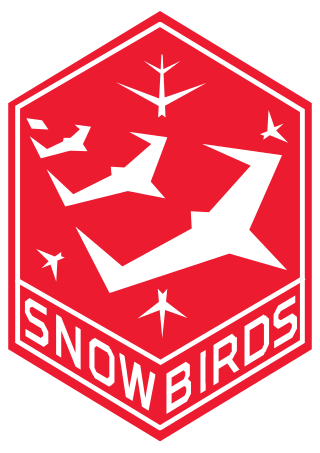
The Snowbirds, officially known as 431 Air Demonstration Squadron, are the military aerobatics flight demonstration team of the Royal Canadian Air Force. The team is based at 15 Wing Moose Jaw near Moose Jaw, Saskatchewan. The Snowbirds' official purpose is to "demonstrate the skill, professionalism, and teamwork of Canadian Forces personnel". The team also provides a public relations and recruiting role, and serves as an aerial ambassador for the Canadian Armed Forces. The Snowbirds are the first Canadian air demonstration team to be designated as a squadron.
The history of the Royal Canadian Air Force begins in 1914, with the formation of the Canadian Aviation Corps (CAC) that was attached to the Canadian Expeditionary Force during the First World War. It consisted of one aircraft that was never called into service. In 1918, a wing of two Canadian squadrons called the Canadian Air Force (CAF) was formed in England and attached to the Royal Air Force, but it also would never see wartime service. Postwar, an air militia also known as the Canadian Air Force was formed in Canada in 1920. In 1924 the CAF was renamed the Royal Canadian Air Force (RCAF) when it was granted the royal title by King George V. The RCAF existed as an independent service until 1968.

The de Havilland Canada DHC-1 Chipmunk is a tandem, two-seat, single-engined primary trainer aircraft designed and developed by Canadian aircraft manufacturer de Havilland Canada. It was developed shortly after the Second World War and sold in large numbers during the immediate post-war years, being typically employed as a replacement for the de Havilland Tiger Moth biplane.
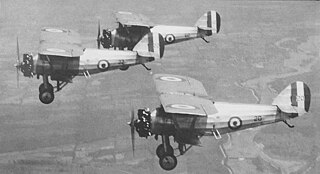
The Armstrong Whitworth Siskin was a sesquiplane single-seat fighter aircraft developed and produced by the British aircraft manufacturer Armstrong Whitworth Aircraft. It was also the first all-metal fighter to be operated by the Royal Air Force (RAF), as well as being one of the first new fighters to enter service following the end of the First World War.

Air Commodore Leonard Joseph Birchall,, "The Saviour of Ceylon", was a Royal Canadian Air Force (RCAF) officer who warned of a Japanese attack on the island of Ceylon during the Second World War.

The Golden Centennaires were a Royal Canadian Air Force (RCAF) aerobatic flying team that performed in 1967, the Canadian Centennial year. The team was created to celebrate the Canadian Centennial. The eight-plane formation team, commanded by Wing Commander O. B. Philp C.M., DFC, CD, featured six-plane formations alternating with two solo aircraft. The aircraft used was the CT-114 Tutor, which sported a blue and gold paint scheme.

The Golden Hawks were a Royal Canadian Air Force (RCAF) aerobatic flying team established in 1959 to celebrate the 35th anniversary of the RCAF and the "Golden" 50th anniversary of Canadian flight, which began with the AEA Silver Dart in 1909.
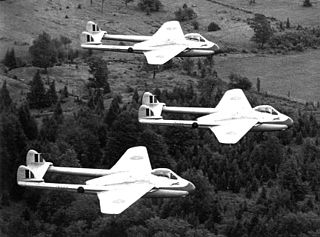
The Blue Devils or the 410 (F) Squadron Aerobatic Team was a Royal Canadian Air Force (RCAF) aerobatic team that flew the de Havilland Vampire jet aircraft from 1949 to 1951. The unit was the RCAF's first postwar aerobatic team, and belonged to the RCAF's first operational jet fighter squadron, No. 410 Squadron.

RCAF Station Grostenquin, also known as 2 (Fighter) Wing or 2 Wing, was a Royal Canadian Air Force (RCAF) station located five km north of the town of Grostenquin in the Moselle department, Lorraine, northeastern France. It was one of four RCAF wings, consisting of three fighter squadrons each, established in Europe in the early 1950s at the beginning of the Cold War. The other three wings were located at RCAF Station Marville in France, and RCAF Station Zweibrücken and RCAF Station Baden-Soellingen in the former West Germany.

The Canadair Sabre is a jet fighter aircraft built by Canadair under licence from North American Aviation. A variant of the North American F-86 Sabre, it was produced until 1958 and used primarily by the Royal Canadian Air Force (RCAF) until replaced with the Canadair CF-104 in 1962. Several other air forces also operated the aircraft.
Lieutenant-General Donald Currie Laubman, was a Second World War Canadian fighter pilot and flying ace. He remained in the Canadian armed services after the war rising to the rank of Lieutenant-General.

The Beechcraft CT-134 Musketeer is a military training derivative of the Musketeer built by Beechcraft for the Canadian Armed Forces. The CT-134 was a single engine, low-wing, four-seat light aircraft with fixed landing gear and a limited aerobatic capability.

The Canadian Aviation Corps (CAC) was an early attempt to create an air force for Canada at the beginning of the First World War. The unit was created in 1914 and was attached to the Canadian Expeditionary Force. The CAC had a maximum strength of three personnel and one aircraft which was delivered but never used. By May 1915, the unit had ceased to exist.

The Canadian Air Force (CAF) was a contingent of two Canadian air force squadrons – one fighter and one bomber – authorized by the British Air Ministry in August 1918 during the close of the First World War. The unit was independent from the Canadian Expeditionary Force and the Royal Air Force (RAF).

The Avro Canada CF-103 was a proposed Canadian interceptor, designed by Avro Canada in the early 1950s as a development, and possible replacement of the company's CF-100 Canuck, that was entering service at the time with the Royal Canadian Air Force (RCAF). Although intended to be capable of flying at transonic speeds, the CF-103 only offered a moderate increase in performance and capability over the CF-100; subsequently, the aircraft never progressed beyond the mock-up stage.
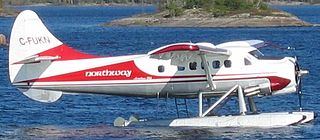
The history of aviation in Canada begins with the first manned flight in a balloon at Saint John, New Brunswick in 1840. The development of the aviation industry in Canada was shaped by the interplay of Canadian national ambitions, national and international politics, economics, and technology. Experimental aviation started in Canada with the test flights of Bell's Silver Dart in 1909, following the epochal flight of the Wright Brothers in 1903. The experimental phase gave way to use of aircraft in warfare. Many Canadians served in the British Royal Flying Corps and Royal Air Force during the First World War.
Lt. Col (Ret.) Joseph Armand Gerard Fernand Villeneuve was a Canadian aviator who joined the Royal Canadian Air Force (RCAF) in 1950 and was the first leader of the RCAF's Golden Hawks aerobatic team. He flew for 32 years as a military jet fighter pilot Villeneuve was inducted into the Canadian Aviation Hall of Fame in 2006.
Colonel Owen Bartley Philp, CM, DFC, CD was a Canadian air force officer who was instrumental in the formation of the Golden Centennaires aerobatic team, commanded the Golden Centennaires, and was founder of the Snowbirds aerobatic team. Philp was made a Member of the Order of Canada in October 1992 and was inducted into the Canadian Aviation Hall of Fame in 2015.
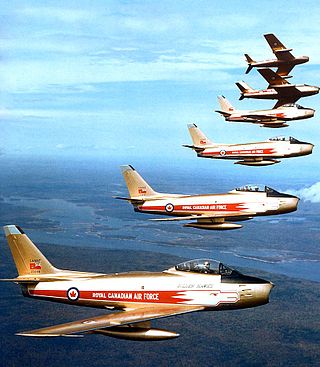
James David McCombe was a Royal Canadian Air Force (RCAF) pilot who was a commander of the Golden Hawks aerobatics team. His career with the RCAF spanned 23 years.
Air Defence Command was a command of the Royal Canadian Air Force and later the Canadian Armed Forces, active from 1951 to 1975.















